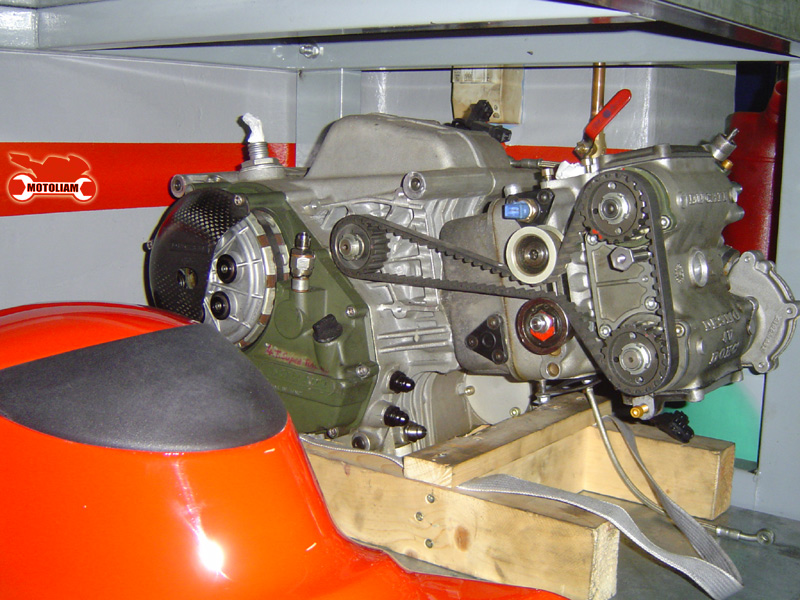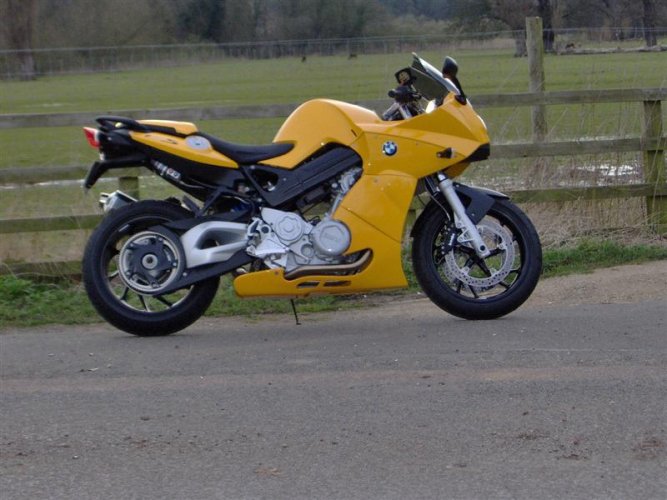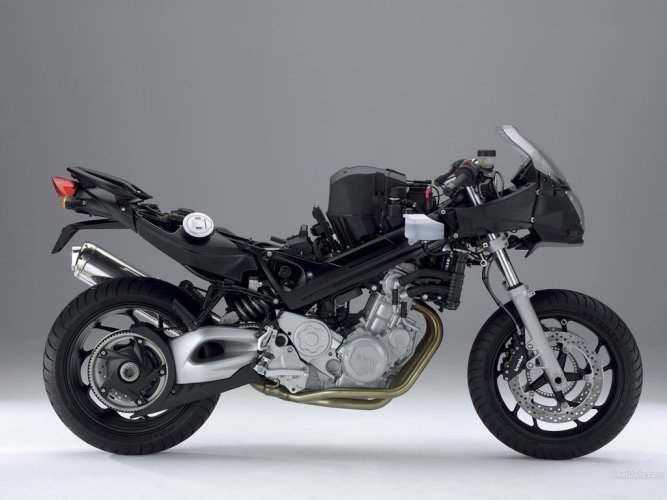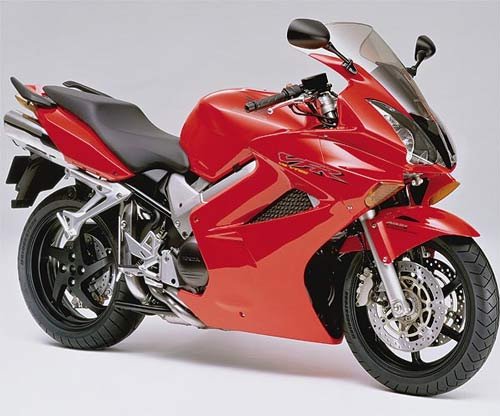kbasa
Well-known member

I've heard the hype. You've heard the hype. Hell, by now, just about everybody's heard the hype. According to Bike, the F800ST has dethroned the VFR as their favorite bike. Given that Bike has never been especially kind to BMW, this is pretty stunning news. Also, given that I've had a VFR I bought new in 1998, I was curious about whether this could, somehow, be true. If it turned out to be so, you'd have to believe Soichiro-san is doing the macarena in his grave, trying to get out.
So, once again, the guys at Marin BMW kindly hooked me up with a bike to ride around. I was loaned an F800ST in this funky color called Graphitan Metallic Matte. It's representative of a new flavor of paint that BMW seems to be applying to not only bikes, but cars. The color is rich, but it just doesn't shine. I've seen it in a silver variant on the K12R Sport and on the Z4 Roadster. It has a tendency to highlight the interesting contours BMW seems to be building into their bodywork these days; cars or bikes. It seems durable enough, BMW having a long history of fine paintwork, but the matte finish isn't to everyone's liking. It is, however, more creative than the matte black that Honda has foisted on the VFR and Aprilia and Ducati seem to have allowed to spread like an infection among their product lines. Apparently, Flat Black is the new Black. Who woulda thunk?
So let's look beyond the paint and check out the naughty bits.
Drivetrain
It would be tempting to write this motor off as a larger version of an EX500, GS500 or a strange Teutonic cousin of the evergreen Bonneville. How complicated can you make a parallel twin? Well, the German engineers have a saying, "Why make it simple when you can make it complicated"?
While the F800 powerplant looks fairly conventional on the outside, this motor has a very unusual solution to vibration. In most motors, vibration has traditionally been damped out by a rotating counterweight that moves in opposite phase to piston movement. Everybody uses them. BMW uses them in the R1200s, HD even uses them in some of the big motors. They're pretty effective. Ducati, however, came up with a different solution a decade or so back. They built a limited production run of a bike called the Supermono. It was a single cylinder race bike that was, essentially, a standard Duc motor with one of the cylinders lopped off. (The upper one, if you care). Realizing that they'd need to do something about vibration, Ducati installed a mass that weighed what the missing piston would weigh to the other crank throw. The mass had a mount in the case and the other end on the end of a rod, perfectly mimicking the missing piston's mass and yielding a surprisingly smooth single.
In this photo, you can see where the mass lives in the Supermono motor.

So, you may ask, what does this have to do with the F800? The F800 has adopted a similar mass system to dampen vibration. BMW has both pistons moving up and down at the same time, which would lead to a very buzzy motorcycle. Given that we're talking about a BMW, this simple won't do. The engineers needed a solution and used a solution similar to the SuperMono. It is, as far as I know, the only time a production motorcycle has used this solution.
In the photo below, not how the mass is attached to a crank throw between the pistons. I'm guessing that the effective mass of this structure is equal to the two pistons.

What this means in real life is that you have a bike that operates much like a BMW boxer motor. It has the same kind of sound, makes the same kind of power and exhibits much of the same vibration tendencies of a boxer.
Engine controls are via BMW's BMSK system, incorporating fuel injection and catalytic converter. The engine fires right up, sets into an idle quickly and is ready to ride immediately without stumbling or hesitation. Engine note is similar to a boxer motor, but quite raspy. Like my VFR, this bike makes more motorcycle noise than you'd expect, especially given BMW's reputation for making quiet bikes. Running a 12:1 compression ratio seems to dictate fairly sophisticated engine controls. While I didn't see anything like a detonation sensor, I'd imagine with a compression ratio like that, there's one in the system. The R1200 motors carry them, so it would make sense for this bike.
Exhaust system offers a slightly different interpretation of the R1200GS' dual outlet muffler.

I found torque to be a virtually flat spread from just off idle to redline. I could lug the bike out of a 20mph corner in 2nd gear without vibration or shuddering; it just pulled right out and powered up the hill. At highway speeds, you don't really need a downshift to effect real acceleration, power is readily available anywhere. Unlike the more recent boxers, this bike doesn't feel like you need to wind it up to make it move. BMW quotes 85hp at 8K rpms and 63ft. lbs at 5800 rpms, which seems about right.
Vibration was a sort of low frequency, high amplitude variety that shifted from contact point to contact point through the rev range. At highway speeds of 70 or so, it was calm, with just enough going on to let you know there's a motor running in the bike. At higher speeds, vibes moved through the pegs and up to the tank. Bar vibration wasn't noted, but after riding an R11S for a few years, I'm somewhat immune to bar vibration.
Like the F650 and G650, this powerplant incorporates the transmission, rather than the separate transmission and dry clutch found elsewhere in BMW's lineup. Unusually, the swingarm mounts to the rear of the case. Honda did this a few years back with the Superhawk and the VFR as they tried to allow some level of lateral flex in the chassis. With chassis getting stiffer and stiffer, bikes began to have trouble with chassis compliance when leaned over. Honda sought to tune the chassis through what they termed Tuned Flex. It appears that BMW has attempted something similar.
The engine and transmission are clearly a stressed member in this configuration. The engine bolts to the side rails quite clearly and the frame, instead of connecting to the motor via the usual sideplate arrangement, bolts to a boss on the rear of the engine. The objective of a chassis is to keep the swingarm and the steering head in as direct connection as possible. I'd say that this chassis has accomplished this quite readily.
Note the detailing on the swingarm pivot. This design theme matches the R1200GS and other bikes in the BMW lineup. The black mass coming down from above and bolting to the case is the rear of the frame. The large black mass in the upper right is the plastic fuel tank, mounted under the seat. Clutch is actuated by cable. Dipstick should keep the traditionalists happy.

BMW transmissions have typically been a sore spot with reviewers and riders. They've traditionally been clunky affairs, requiring the rider to preload the shifter, shift at higher revs or the like. This has been largely resolved in the latest generations of R1200s and K1200s. This bike is no different. The transmission shifts readily and crisply. Gear ratios, combined with the flexible power delivery make this bike very easy to ride. First gear is low enough that parking lot maneuvering and lane splitting are accomplished easily, yet 6th is high enough that 80mph cruising is simple.
Final drive is something unusual for a BMW. Previously BMW had only offered belt drive on the unlamented F650CS. This bike has belt drive as part of either the S or ST variant. It's wonderful. No final drive lash. No chain to maintain. And, for the skeptics, no exploding final drives. In the F650CS, BMW had a recall for a bad batch of rear sprockets, so one would hope that they've done their homework this time as well. The part looks similar to the CS part, but I'm not enough of an F650 aficionado to say for certain. With the single sided swingarm, it appears the belt replacement will be a trivial task. I see removal of the various covers and guards, along with unbolting the right footpeg bracket as about the extent of it.
Swingarm is massive and, one would assume, strong. Primary cover is clearly indicated by the big gear. Belt cover encases almost the entire belt, which makes me wonder if BMW will keep this scheme for the F800GS. Hint, hint, BMW. We want it.

Chassis
Unlike the oilheads, which have no discernible traditional chassis, the F800 has a fairly conventional twin spar frame with the powerplant as a stressed member. Frame sections are large and appear to be strong. The rear subframe is a tubular unit that carries the fuel tank. The tank itself is a plastic unit that carries 4 gallons. I saw about 50mpg on this bike, which would yield a 200 mile range. By keeping my hand out of it, I saw mileage as high as 66mpg on the instant mpg monitor.
Suspension is via a massive and competent Showa shock offering about 5.5 inches of travel. Preload is via a simple and accessible knob living in a recess on the right side of the frame. Rebound damping is readily accessible and adjustable via a triangular knob on the other end of the shock. Again, in typical BMW fashion, there isn't any rocker linkage, rising rate or other magic. For those of us old enough to remember them, this is a "lay down" shock.
Preload knob in frame recess. Note placement of accessory outlet. C'mon BMW. On the right hand side?

Preload adjuster can be operated without a screwdriver. Why doesn't every manufacturer do this and why doesn't BMW do it on all their bikes?

The 43mm forks are reasonably compliant but don't, to my knowledge offer preload or damping adjustment. Like the rear, they offer about 5.5 inches of travel, which is decent for a dedicated road bike. Overall, I found the suspension to be reasonable. It's plenty competent when pushed hard, is nice on longer highway rides and doesn't beat the rider. Larger inputs, like sharp edged bumps can jolt the rider out of the seat, but smaller, less sharp inputs are handled readily. As a long time BMW rider, I've long been accustomed to throwing away the invariably oversprung and underdamped stock units. These shocks are a welcome change. I first noted this when I bought an R1200GS three years ago, but other bikes I've ridden in the lineup have shown varying degrees of success.
Wheels seem to mimic the design found on the ST and RT boxers. The rear wheel, however, is more like a VFR wheel. Unbolting the wheel leaves the disc rotor, belt and everything behind. Wheel removal should be simple.
Front wheel sports a design like this bike's bigger siblings. Brembo gear is capable and offers up wonderful feel. ABS is included, as well as BMW's new EVO braking system.

Rear wheel is flatter than other BMW wheels to accomdate the single sided swingarm. Removal should be a snap.

Ergonomics
The bike I rode had a low seat installed, which yielded a set to peg height of about 17 inches. This is fairly tight, but not uncomfortably so. The pegs are set far enough back that your hips don't get pinched, which was our experience with our R1150R. The pegs, in addition to being high on that bike, were forward, which folded us at the hips. Not good. The standard seat is an inch or so higher, yielding a seat height of just over 32 inches. With the low seat, Tina, who's 5'5", could almost flat foot the bike. The front of the seat is narrow, which helps those of shorter inseam get their legs down. I'm 6' with a 32" inseam and I had bent knees when I sat on it.
Windblast is nicely managed by the short shield. It functions much like an S fairing off of an old airhead, with windblast hitting the rider mid chest and the helmet in clean, quiet air. I'd imagine taller shields will be available for those that need to have more noise and turbulence in their lives.
Resistance to side winds seemed to be relatively good for a lightweight, fully faired motorcycle.
Bars are tubular and wide. The F800S uses a clip-on arrangement which makes the bars a couple inches lower. Steering effort is light. When I first started riding this bike, I kept turning in early. The wide bars give it a different character and faster response than the F800S I'd ridden a couple weeks earlier.
Vibration through the bars doesn't seem to be an issue. Switchgear is standard BMW, with the turn signals that you either love or don't care about. The bike has a little INFO button that you can use to cycle through a series of informational displays. MPG currently, riding time, distance, etc. For the touring rider, this will be easier than trying to compute time speed distance problems while riding.
Since this is a CanBus bike, BMW seems to have saddled this bike with the same 5amp limit as the GS. It wouldn't operate my Gerbings. I see Touratech producing an F800 CanBus Helper kit for this bike, I'd bet. The Lone Glaring Fault is the placement of the accessory outlet on the right side of the bike. While I didn't get tangled up in it when mounting and dismounting, it was hard to operate the switch on my Gerbings while riding. Whoever comes up with a nice relocation kit for the outlet will find a willing market.
Switchgear looks remarkably like the switchgear on the R1200 series. Heated grips are effective and were welcome.

Instrumentation is clear and readable under most lighting conditions. Like the GS, this has a red backlight that comes on courtesy of a sensor that reads ambient light. Gear position indicator is large and clear and fuel gauge and temp bars seem accurate. Clocks are stacked top and bottom and seem to be the same as the R1200R cluster. There are plenty of little hash marks on the faces, so trying to figure out whether you're riding 50, 55 or 60 can require a second look. I'm sure familiarity with the speedo would solve this.

So, how does this bike compare to my trusty VFR? I think it's safe to say that this bike is certainly in the same league as the hallmark of sport touring. Additionally, the F800 weighs in at 412 pounds dry, compared to the VFR's 481 pounds. Power for the F800 is about 85hp, while the VFR is generally regarded to be about 100hp. I think we're looking at very similar power to weight ratios, which should yield similar performance. Both have ABS, both have factory bags. The BMW comes with a power outlet, you can get factory heated grips.
OK, so pricing. BMWs have always been priced higher than the competition, but I think they're right in the ballpark with this one. VFRs are checking in between $11,500 and $12,100. Surprisingly, the F800 starts at $10,475, a full thousand dollars below the VFR. Of course, adding ABS and such will raise the price to VFR levels, but we're still right in the ballpark for pricing. How nice is it to have a BMW offered at a price that's competitive with the Japanese, all the while offering typical BMW build quality and design?
I was out riding the F800 and stopped in Nicasio, CA for a couple minutes. As I was standing there, a guy walked up to me (Hi, Ty!) and started bubbling over about the F800. Fair enough. He's one of the assimilated, riding an 1150RT. Then, two guys, probably late 20s to early 30s pulled up. One was on a GSX-R 750 and the other on a fairly well modded SV650. They thought the F was pretty nice and started talking about a friend of theirs that had just bought a BMW. One of them said to the other, "Everybody's buying Beemers, man" and his friend nodded in agreement.
Has BMW finally built the bike that will pull people into the marque? I think they might have. It's priced right, it's got a roundel, it requires no excuses like "it's fast - for a BMW".
This might be the bike that snares a whole new generation of BMW rider.










